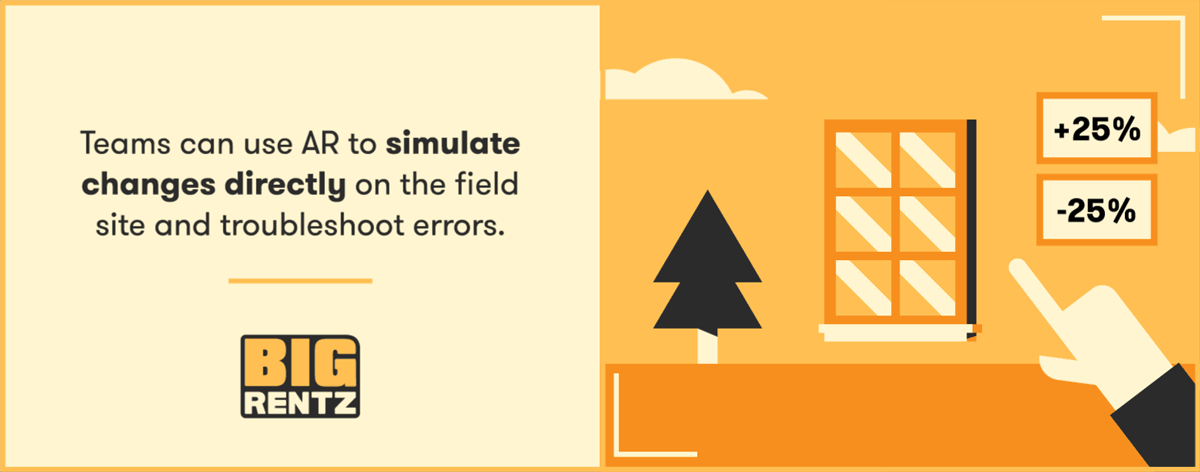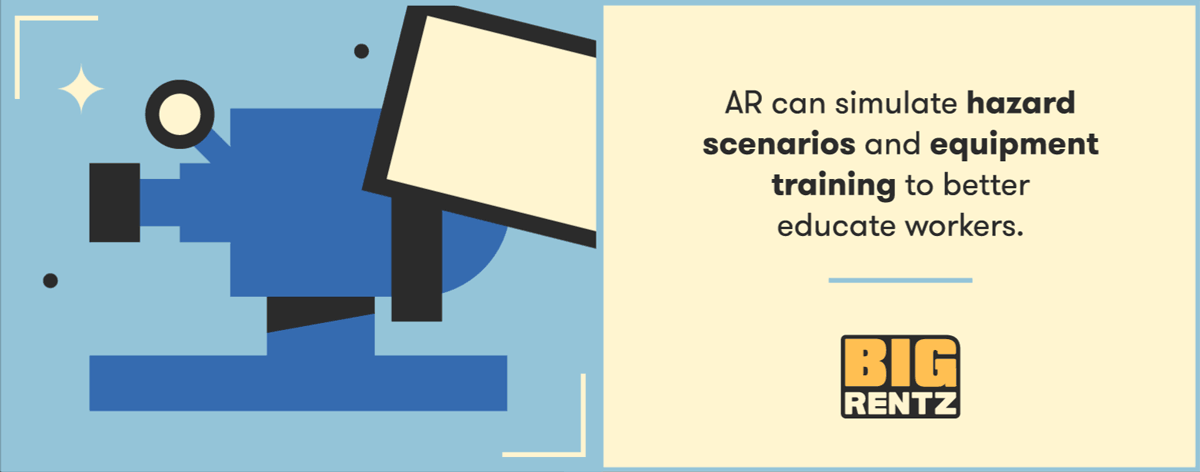The construction job site is changing. Paper drawings, sketches and design plans are giving way to drones, 3D models and a new interactive experience called augmented reality.
Augmented reality, or AR for short, is one of the most talked-about technology trends in construction. Using advanced camera and sensor technology, AR combines one’s physical surroundings with computer-generated information and presents it in real time. While video games have used the technology for years, this “augmented” experience is recently making waves in construction, offering immense opportunities to improve the project life cycle.
By combining digital and physical views, augmented reality helps construction teams drive more efficiency, accuracy and overall confidence in their projects. The AR global market is expected to reach $300 billion by 2024. Rather than replacing workers on the field, AR will greatly enhance the ways humans and digital machines work together.
As the technology continues to mature and become adopted, augmented reality in construction will become an invaluable tool — and even has the potential to change the future of building. Read on to learn about the different ways AR will benefit the industry in 2022 and onward.
How Does Augmented Reality Work?
Whereas virtual reality is strictly a digital experience, augmented reality combines the physical and digital world into one immersive environment. AR projects 3D images on a person’s physical surroundings as they walk through with a mobile device or special helmet.
Using GPS and cameras, AR can present real-time data geospatially, updating and displaying the necessary information as the user moves throughout a building space. Information such as schedules, operational details, and structural plans are easily accessible, allowing users to automate the construction process and make decisions on-site.
How is AR Used in Construction?
With the ability to provide real-time information, augmented reality is being used within the industry to increase efficiency, improve safety, streamline collaboration, manage costs and boost overall project confidence. Here are some of the ways construction teams are using AR to streamline the building process.
1. Project Planning
New developments in augmented reality are making it possible to generate 3D models directly on a 2D plan. Combined with 3D modeling software and building information modeling (BIM), construction companies can produce detailed, interactive models of building projects and present them to clients at the start of a project. This allows clients to get a realistic view of project outcomes and make any changes before construction begins. Getting this level of client involvement early in the process helps prevent costly changes later and keeps clients engaged.
Accuracy is an important component of any construction project. AR also allows teams to conduct walk-throughs of the entire project before it is executed, closely examining the details and components of the structure. This foresight can prevent schedule delays, reduce cost overruns and identify any mistakes before they surface.
2. Automated Measurements
Augmented reality gear can measure a space’s physical properties, including its height, width and depth. Construction companies can incorporate this data into models, allowing them to generate more accurate structures and gain a comprehensive view of how the project will look. Having precise measurements in advance makes it easier to create accurate material and labor estimates and an efficient project timeline.
Augmented reality is also being developed to allow field workers to automate measurements on-site during construction. When wearing an AR unit, workers will be able to tap to automatically make measurements of the built components and compare them against the measurements specified in the building models. This allows workers to find any inconsistencies in the structures and quickly adjust them to prevent higher costs and delays down the line.
3. Project Modifications
One major innovation in augmented reality is its ability for users to make changes to building models directly on the field site. Using a headset or mobile device, workers can easily display interior and exterior views of a structure and make modifications to the virtual plans while keeping the original view intact. For example, engineers will soon be able to virtually remove and relocate structural components and modify a building’s layout with just a few taps on their AR-enabled device.
This application will be particularly useful for engineers, as it allows them to troubleshoot any errors in a virtual view before applying changes to the physical structure. Since this digital data is continuously updated, it removes the guesswork from project changes while improving workflow and preventing wasted materials.
4. On-Site Project Information
The ability to combine all digital information and documentation with one’s physical view is a game-changer for on-site crews. Field workers can view information like the locations of pipes, walls, outlets, switches and ventilation, and toggle between layers to help monitor a project against its building plan and ensure successful project closeout. For example, a contractor can use a headset or tablet to see the locations of each drill hole specified in the building plans and ensure proper placement.
In addition to providing a useful information database, AR allows users to virtually see the building’s progress against its schedule. As the industry continues to struggle with productivity, this application will prove to be an indispensable part of project management.
5. Team Collaboration
Construction projects require a great deal of collaboration between multiple teams, including carpenters, electricians, plumbers, welders, designers and managers. A successful collaboration ensures that a project is completed on time and according to the proposed budget.
However, all workers involved in a project are not always present on a job site. Any errors that arise must wait for all the parties involved to assemble and review blueprints and make any changes. AR allows all users to share notes and videos of errors or design issues in real time, reducing the cost and time it takes to resolve problems.
6. Safety Training
Safety is a common challenge in the construction industry. Safety programs cost a lot of time and money and aren’t always properly communicated to workers. With the help of an AR headset, however, workers can access virtual drills, instruction and safety scenarios. This style of direct learning not only improves their awareness of safety and provides intuitive training, but also reduces training costs and downtime.
Engineers are also exploring the possibility of using augmented reality to create virtual models of equipment like cranes and boom lifts. With this technology, workers will be able to use their headsets to practice operating heavy machinery in a safe, virtual setting, further enhancing their learning and development.
Current AR Technologies Used in Construction
Companies are constantly innovating and creating new AR technologies. The following products are already making waves in the industry by offering more efficient ways to plan and construct buildings.
Akular AR
Akular AR is a cloud-based technology that allows users to view 3D models of physical spaces using a smartphone or tablet. It not only optimizes BIM models and allows users to view them on-site, but also allows team members to send information — like BMS and IoT sensor data — in real time.
AR Instructor
The company Arvizio created AR Instructor to provide a new type of on-the-job training for the construction and manufacturing industries. This technology guides users through various tasks using pre-prepared augmented reality instructions. Off-site trainers can supplement each step with 3D models, videos, documents or images superimposed over a user’s physical surroundings.
ARki
ARki is an app that allows designers to create 3D models and superimpose them on top of their surroundings or 2D floor plans through their phone camera. Users can upload files, create models and then virtually connect with other team members to easily share their notes and designs.
AR Headsets
AR headsets are one of the most common augmented reality technologies workers use on construction sites. They can be worn with safety helmets and allow users to view superimposed 3D models and project plans while leaving their hands free. They can also collect digital measurements and integrate them into existing models to keep them up to date.
Pros and Cons of AR
While augmented reality provides instant results and can positively impact your business’s project life cycle, there are important pros and cons to consider.
Benefits
Finishing a project on time and within budget is a crucial part of the construction process. AR provides the tools for construction companies to plan a project from start to finish, ensuring accuracy, preventing rework and saving building costs. This overall precision and efficiency can afford construction companies greater confidence in their projects, improving client relations and creating long-term ROI.
Limitations
Despite its potential, augmented reality still needs to gain momentum before achieving widespread use. Comfort and safety are major concerns for users wearing AR headsets for long working hours. The equipment is often susceptible to adverse weather conditions and functions best with a solid internet connection and static environment. These are all factors that aren’t always present on construction job sites.
According to the McKinsey Global Institute, construction is second on the list of the least digitized major industries. A new application like AR comes with a learning curve that may deter companies from investing in the technology.
The Future of AR in Construction
As technology continues to evolve, a number of applications are beginning to harness the abilities of AR. Apps like SmartReality allow users to generate 3D models on any 2D plan, and Pair 3D allows architects to drop furnishings into their designs to determine the building’s visual impact. Canadian startup Sensopia created magicplan, an AR app that allows users to estimate material costs on generated models and order directly on the app.
Although only large construction firms have fully scaled AR so far, it will become more accessible in the coming years as the technology comes down in costs and 5G networks expand. Many companies are offering the technology on a per-project basis and with free trials, allowing construction managers to experiment with the new technology and apply it to their business.
From eliminating errors to offering insight, augmented reality in construction can effectively streamline the entire project life cycle. Companies investing in this innovative technology are already enjoying the benefits, and it is a cutting-edge trend that can no longer be ignored in the industry. In 2022, the technology will continue to mature and become economically feasible, while seeing increased investment and adoption. Like forklifts and power tools, we can expect this innovative technology to become a common fixture on construction sites moving forward.
Additional Sources:
eSUB | PlanGrid | Autodesk | Construction Dive | SRI International | Wired | Geospatial World | American Journal of Engineering Research | Jasoren | Tech Trends | Capterra | AZ Big Media | PHPC Pros | GenieBelt | Cubicle Ninjas | Intellectsoft | GBKSoft

















